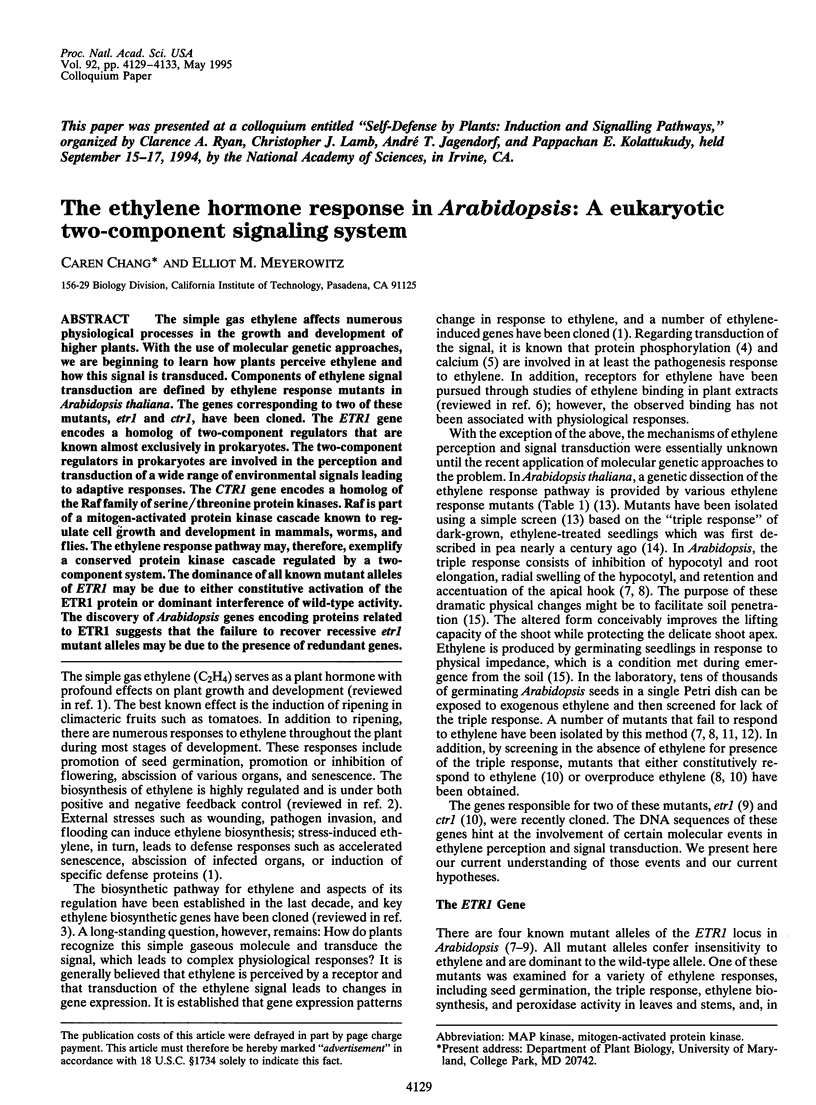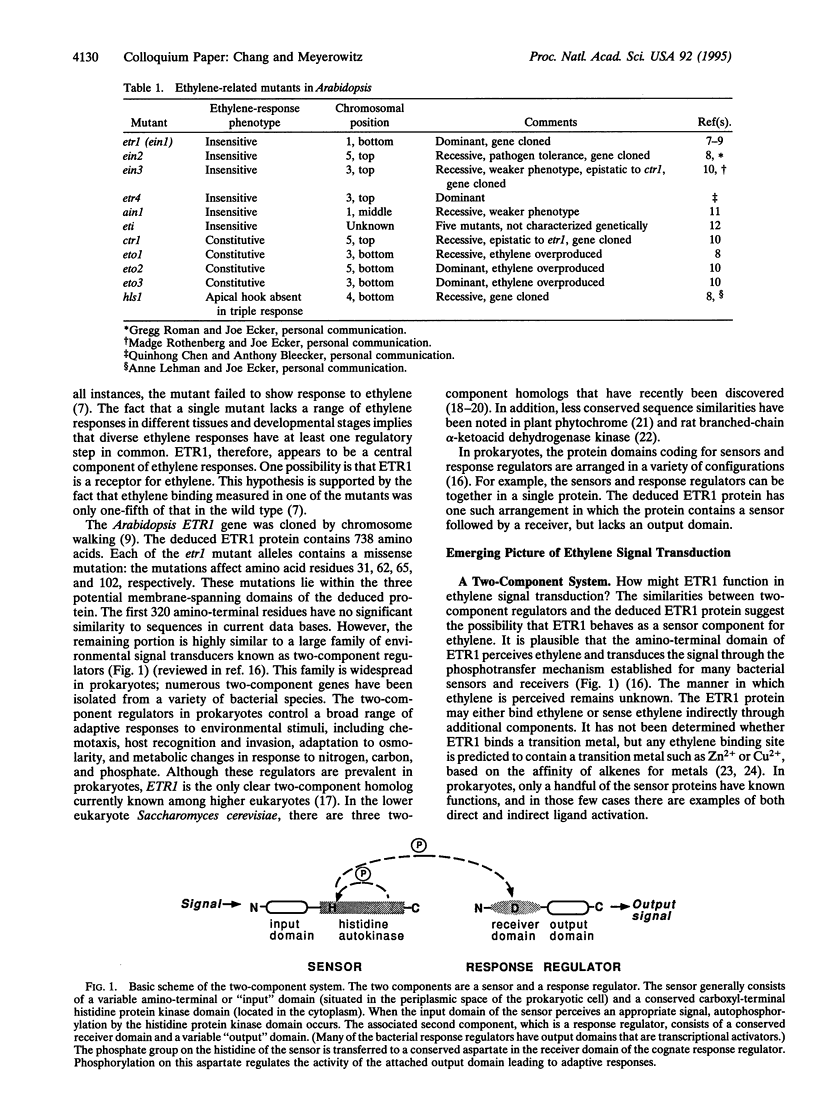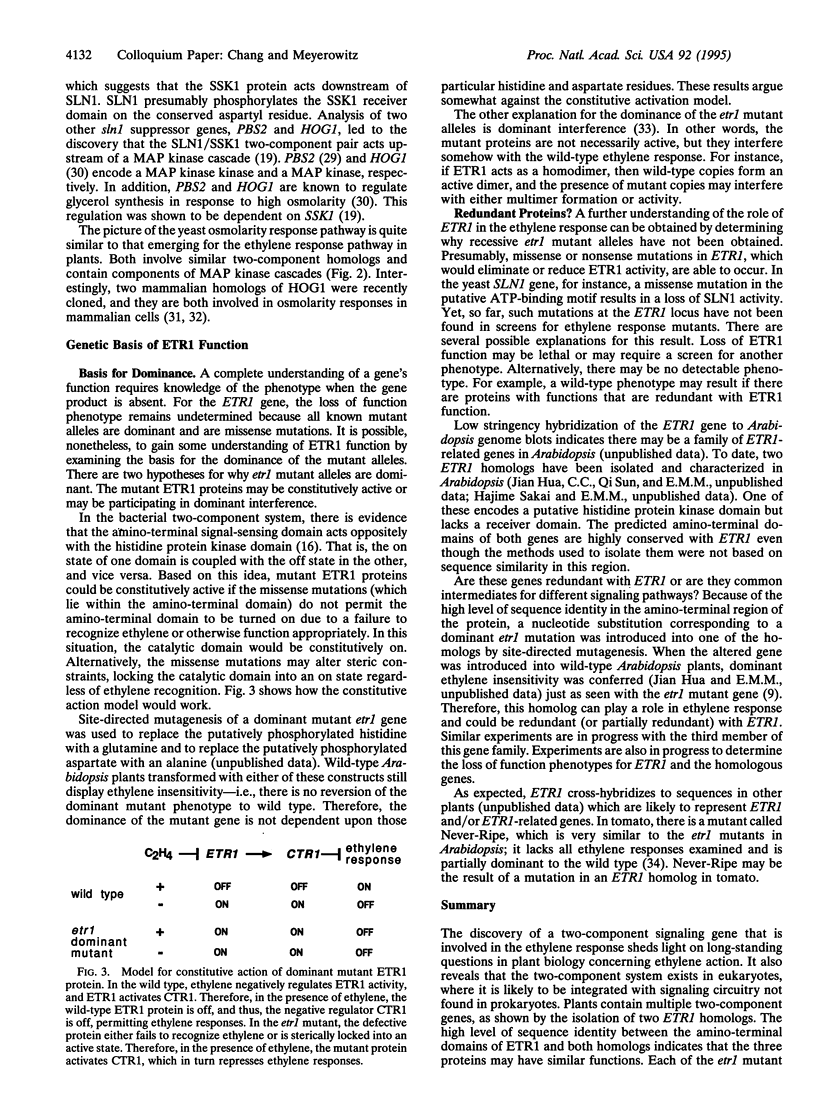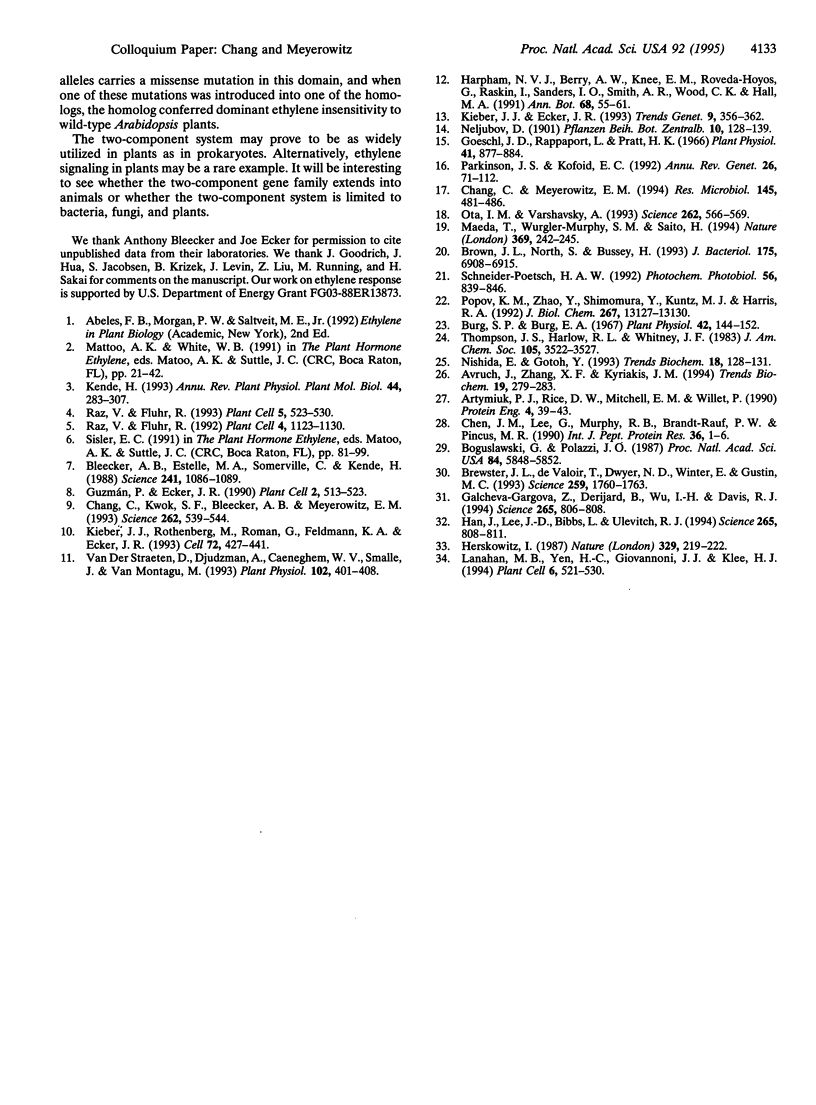Abstract
The simple gas ethylene affects numerous physiological processes in the growth and development of higher plants. With the use of molecular genetic approaches, we are beginning to learn how plants perceive ethylene and how this signal is transduced. Components of ethylene signal transduction are defined by ethylene response mutants in Arabidopsis thaliana. The genes corresponding to two of these mutants, etr1 and etr1, have been cloned. The ETR1 gene encodes a homolog of two-component regulators that are known almost exclusively in prokaryotes. The two-component regulators in prokaryotes are involved in the perception and transduction of a wide range of environmental signals leading to adaptive responses. The CTR1 gene encodes a homolog of the Raf family of serine/threonine protein kinases. Raf is part of a mitogen-activated protein kinase cascade known to regulate cell growth and development in mammals, worms, and flies. The ethylene response pathway may, therefore, exemplify a conserved protein kinase cascade regulated by a two-component system. The dominance of all known mutant alleles of ETR1 may be due to either constitutive activation of the ETR1 protein or dominant interference of wild-type activity. The discovery of Arabidopsis genes encoding proteins related to ETR1 suggests that the failure to recover recessive etr1 mutant alleles may be due to the presence of redundant genes.
Full text
PDF




Images in this article
Selected References
These references are in PubMed. This may not be the complete list of references from this article.
- Artymiuk P. J., Rice D. W., Mitchell E. M., Willett P. Structural resemblance between the families of bacterial signal-transduction proteins and of G proteins revealed by graph theoretical techniques. Protein Eng. 1990 Oct;4(1):39–43. doi: 10.1093/protein/4.1.39. [DOI] [PubMed] [Google Scholar]
- Avruch J., Zhang X. F., Kyriakis J. M. Raf meets Ras: completing the framework of a signal transduction pathway. Trends Biochem Sci. 1994 Jul;19(7):279–283. doi: 10.1016/0968-0004(94)90005-1. [DOI] [PubMed] [Google Scholar]
- Bleecker A. B., Estelle M. A., Somerville C., Kende H. Insensitivity to Ethylene Conferred by a Dominant Mutation in Arabidopsis thaliana. Science. 1988 Aug 26;241(4869):1086–1089. doi: 10.1126/science.241.4869.1086. [DOI] [PubMed] [Google Scholar]
- Boguslawski G., Polazzi J. O. Complete nucleotide sequence of a gene conferring polymyxin B resistance on yeast: similarity of the predicted polypeptide to protein kinases. Proc Natl Acad Sci U S A. 1987 Aug;84(16):5848–5852. doi: 10.1073/pnas.84.16.5848. [DOI] [PMC free article] [PubMed] [Google Scholar]
- Boulahdour H., Poncy J. L., Berry J. P., Galle P. Intranuclear sites of Np 237 in mammalian cells: a study using electron microscopy and electron probe microanalysis. Int J Radiat Biol. 1995 Jul;68(1):55–61. doi: 10.1080/09553009514550921. [DOI] [PubMed] [Google Scholar]
- Brewster J. L., de Valoir T., Dwyer N. D., Winter E., Gustin M. C. An osmosensing signal transduction pathway in yeast. Science. 1993 Mar 19;259(5102):1760–1763. doi: 10.1126/science.7681220. [DOI] [PubMed] [Google Scholar]
- Brown J. L., North S., Bussey H. SKN7, a yeast multicopy suppressor of a mutation affecting cell wall beta-glucan assembly, encodes a product with domains homologous to prokaryotic two-component regulators and to heat shock transcription factors. J Bacteriol. 1993 Nov;175(21):6908–6915. doi: 10.1128/jb.175.21.6908-6915.1993. [DOI] [PMC free article] [PubMed] [Google Scholar]
- Burg S. P., Burg E. A. Molecular requirements for the biological activity of ethylene. Plant Physiol. 1967 Jan;42(1):144–152. doi: 10.1104/pp.42.1.144. [DOI] [PMC free article] [PubMed] [Google Scholar]
- Chang C., Kwok S. F., Bleecker A. B., Meyerowitz E. M. Arabidopsis ethylene-response gene ETR1: similarity of product to two-component regulators. Science. 1993 Oct 22;262(5133):539–544. doi: 10.1126/science.8211181. [DOI] [PubMed] [Google Scholar]
- Chang C., Meyerowitz E. M. Eukaryotes have "two-component" signal transducers. Res Microbiol. 1994 Jun-Aug;145(5-6):481–486. doi: 10.1016/0923-2508(94)90097-3. [DOI] [PubMed] [Google Scholar]
- Chen J. M., Lee G., Murphy R. B., Brandt-Rauf P. W., Pincus M. R. Comparisons between the three-dimensional structures of the chemotactic protein CheY and the normal Gly 12-p21 protein. Int J Pept Protein Res. 1990 Jul;36(1):1–6. doi: 10.1111/j.1399-3011.1990.tb00077.x. [DOI] [PubMed] [Google Scholar]
- Galcheva-Gargova Z., Dérijard B., Wu I. H., Davis R. J. An osmosensing signal transduction pathway in mammalian cells. Science. 1994 Aug 5;265(5173):806–808. doi: 10.1126/science.8047888. [DOI] [PubMed] [Google Scholar]
- Goeschl J. D., Rappaport L., Pratt H. K. Ethylene as a factor regulating the growth of pea epicotyls subjected to physical stress. Plant Physiol. 1966 May;41(5):877–884. doi: 10.1104/pp.41.5.877. [DOI] [PMC free article] [PubMed] [Google Scholar]
- Guzmán P., Ecker J. R. Exploiting the triple response of Arabidopsis to identify ethylene-related mutants. Plant Cell. 1990 Jun;2(6):513–523. doi: 10.1105/tpc.2.6.513. [DOI] [PMC free article] [PubMed] [Google Scholar]
- Han J., Lee J. D., Bibbs L., Ulevitch R. J. A MAP kinase targeted by endotoxin and hyperosmolarity in mammalian cells. Science. 1994 Aug 5;265(5173):808–811. doi: 10.1126/science.7914033. [DOI] [PubMed] [Google Scholar]
- Herskowitz I. Functional inactivation of genes by dominant negative mutations. Nature. 1987 Sep 17;329(6136):219–222. doi: 10.1038/329219a0. [DOI] [PubMed] [Google Scholar]
- Kieber J. J., Ecker J. R. Ethylene gas: it's not just for ripening any more! Trends Genet. 1993 Oct;9(10):356–362. doi: 10.1016/0168-9525(93)90041-f. [DOI] [PubMed] [Google Scholar]
- Kieber J. J., Rothenberg M., Roman G., Feldmann K. A., Ecker J. R. CTR1, a negative regulator of the ethylene response pathway in Arabidopsis, encodes a member of the raf family of protein kinases. Cell. 1993 Feb 12;72(3):427–441. doi: 10.1016/0092-8674(93)90119-b. [DOI] [PubMed] [Google Scholar]
- Lanahan M. B., Yen H. C., Giovannoni J. J., Klee H. J. The never ripe mutation blocks ethylene perception in tomato. Plant Cell. 1994 Apr;6(4):521–530. doi: 10.1105/tpc.6.4.521. [DOI] [PMC free article] [PubMed] [Google Scholar]
- Maeda T., Wurgler-Murphy S. M., Saito H. A two-component system that regulates an osmosensing MAP kinase cascade in yeast. Nature. 1994 May 19;369(6477):242–245. doi: 10.1038/369242a0. [DOI] [PubMed] [Google Scholar]
- Nishida E., Gotoh Y. The MAP kinase cascade is essential for diverse signal transduction pathways. Trends Biochem Sci. 1993 Apr;18(4):128–131. doi: 10.1016/0968-0004(93)90019-j. [DOI] [PubMed] [Google Scholar]
- Ota I. M., Varshavsky A. A yeast protein similar to bacterial two-component regulators. Science. 1993 Oct 22;262(5133):566–569. doi: 10.1126/science.8211183. [DOI] [PubMed] [Google Scholar]
- Parkinson J. S., Kofoid E. C. Communication modules in bacterial signaling proteins. Annu Rev Genet. 1992;26:71–112. doi: 10.1146/annurev.ge.26.120192.000443. [DOI] [PubMed] [Google Scholar]
- Popov K. M., Zhao Y., Shimomura Y., Kuntz M. J., Harris R. A. Branched-chain alpha-ketoacid dehydrogenase kinase. Molecular cloning, expression, and sequence similarity with histidine protein kinases. J Biol Chem. 1992 Jul 5;267(19):13127–13130. [PubMed] [Google Scholar]
- Raz V., Fluhr R. Calcium Requirement for Ethylene-Dependent Responses. Plant Cell. 1992 Sep;4(9):1123–1130. doi: 10.1105/tpc.4.9.1123. [DOI] [PMC free article] [PubMed] [Google Scholar]
- Raz V., Fluhr R. Ethylene Signal Is Transduced via Protein Phosphorylation Events in Plants. Plant Cell. 1993 May;5(5):523–530. doi: 10.1105/tpc.5.5.523. [DOI] [PMC free article] [PubMed] [Google Scholar]
- Schneider-Poetsch H. A. Signal transduction by phytochrome: phytochromes have a module related to the transmitter modules of bacterial sensor proteins. Photochem Photobiol. 1992 Nov;56(5):839–846. doi: 10.1111/j.1751-1097.1992.tb02241.x. [DOI] [PubMed] [Google Scholar]
- Van Der Straeten D., Djudzman A., Van Caeneghem W., Smalle J., Van Montagu M. Genetic and Physiological Analysis of a New Locus in Arabidopsis That Confers Resistance to 1-Aminocyclopropane-1-Carboxylic Acid and Ethylene and Specifically Affects the Ethylene Signal Transduction Pathway. Plant Physiol. 1993 Jun;102(2):401–408. doi: 10.1104/pp.102.2.401. [DOI] [PMC free article] [PubMed] [Google Scholar]



